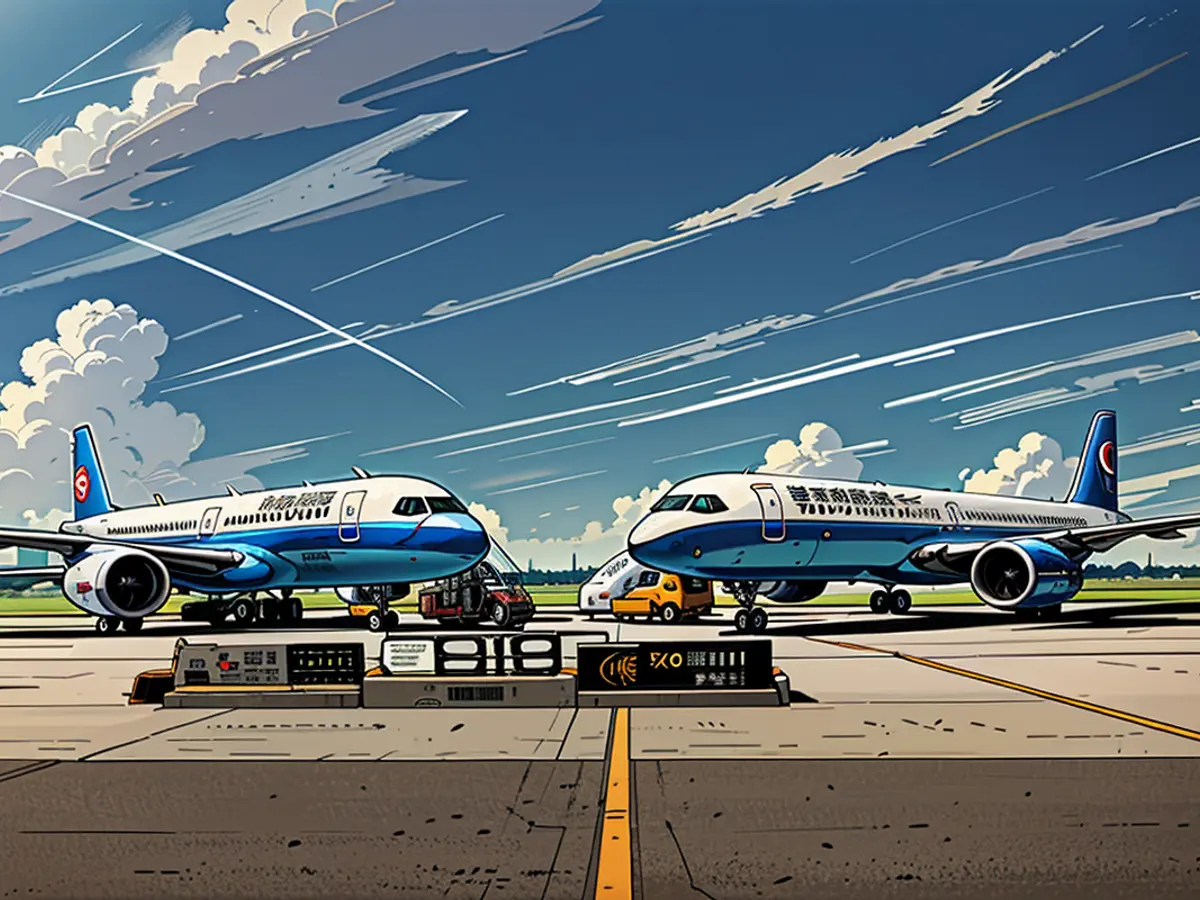The C919 serves as China's counterpart to the A320. Let's delve into the in-flight experiences.
Throughout the week, airlines operate over 60 flights daily between the nation's capital and financial hub, traveling both ways and often utilizing their largest aircraft, such as the renowned Boeing 747 or the modern Airbus A350.
Air China, boasting a fleet of almost 1,000 planes, adopted a narrowbody for a trip on a recent Thursday morning. But this wasn't an ordinary narrowbody; it was Air China's inaugural, and currently sole, C919 jetliner.
The C919 is China's first domestically-manufactured long-haul passenger plane, produced by the Shanghai-based state-owned Commercial Aircraft Corporation of China (COMAC). Following years of development and significant delays, the twin-engine jet embarked on its maiden commercial flight with Chinese carrier China Eastern Airlines in May 2023.
Long regarded as a potential game-changer in global commercial aviation, the C919 represents COMAC's response to the Boeing 737 and the Airbus A320 – two of the world's most popular aircraft types.
Despite securing more than 1,000 orders, the C919 continues to face criticism from skeptics who express concern over its "Chinese origins" (with crucial components, such as engines and flight control systems, sourced from the US and Europe) and its market viability in the face of the Airbus-Boeing duopoly.
As an aviation enthusiast, these controversies couldn't deter my excitement to experience a new aircraft type and review this relatively scarce passenger experience, as there are only a handful of C919s in the sky within mainland China, which is currently its only authorized flight zone.
I arrived at the gate at Beijing's vast Capital International Airport (PEK) an hour before takeoff time to personally gaze upon the C919 for the first time. From a distance, it might be mistaken for an A320 due to its more rounded nose and curved fuselage (in contrast to the B737). More discerning eyes would notice the C919's unique cockpit windows and wingtips.
Upon entering the month-old C919, I was immediately struck by its familiarity; it felt just like an A320, complete with a hint of that new-plane scent. Air China opted for the most spacious configuration among the three state-owned carriers operating C919s, offering 158 seats (with a potential capacity of 192), arranged as eight first-class seats and 150 in economy.
In today's economy class, any additional legroom is a welcome bonus. I had booked an emergency exit row seat and was delighted to find that both exit rows (19 and 20) offered generous legroom even compared to domestic first class. As a 180cm (5'11") individual, I had plenty of space to stretch out with my feet barely touching the seat in front of me.
In terms of the interior, there were individual air nozzles for customized climate control, and economy passengers seated outside of exit rows each had a foldable device holder (for smartphones and tablets) located above their tray tables.
The seats themselves – in the standard 3x3 layout – were on the slim side, popular among airlines thanks to their ability to fit more rows into the main cabin. However, the flight's comfort was enhanced by the complimentary pillows – I positioned one behind me for added cushioning. Under each seat, every three passengers shared two sockets featuring both USB-A and USB-C plugs.
For a jetliner with a maximum range of 5,555 kilometers (approximately 3,500 miles), Air China's C919 appears to rely heavily on passengers for in-flight entertainment. While each seatback included literature space (complete with actual inflight magazines) and pouches for personal belongings, no individual screens or Wi-Fi were available (the dropped-down screens displayed universally unappealing programming), leaving the device holder to fill that void.

The flight attendant proudly announced the aircraft type during the pre-takeoff briefing, "Today, you're flying with Air China C919 aircraft, which is the first large airliner independently developed by China," as the jet taxied to the runway.
Air China serves hot meals in economy during meal hours for all flights, including short-haul trips (this flight's duration: 1 hour 40 minutes). Bottled water was provided in each seatback pouch before boarding, and my omelet – coupled with yogurt and a chocolate bar – tasted satisfactory.
After exploring one of the two economy restrooms located at the back of the cabin, I discovered it to be bright, well-maintained, and less cramped than some of the newer variants found on the A320 or B737.
With the towering Shanghai skyscrapers appearing through the clouds, our plane commenced its descent towards Hongqiao International Airport (SHA).
As a passenger sitting near the engine in the window seat, I recalled the two primary criticisms of the C919 that I had read online: engine noise and limited overhead bin space. While everyone has differing levels of tolerance, I found the engine sound to be comparable to that encountered in typical flights utilizing Boeing or Airbus narrowboady aircraft. The other complaint related to the limited overhead bin space – despite the C919 not being a clear winner in this category, every passenger on this fully-booked flight was able to accommodate their wheeled carry-on luggage without issue.
After a seamless landing in Shanghai around 40 minutes early, there wasn't any clapping or whooping (which isn't common on Chinese planes anyway). Upon disembarking, I noticed a handful of extra passengers – presumably informed by the in-flight announcement about the Chinese-produced C919 – snapping photos of the aircraft.
Navigating a few minor obstacles, the journey turned out to be quite uneventful. Regular fliers like myself, along with many others, probably didn't notice much of a difference between this C919 trip and previous flights on the popular A320 or B737. Based on my personal opinion, this C919 flight deserves a satisfactory B grade in terms of safety and comfort.
Typically, passengers don't select flights based on the aircraft type – unless there's a compelling reason to do so (as demonstrated by several incidents involving Boeing aircraft recently).
COMAC relies heavily on the C919's success, as the Chinese government aims to modernize key industries and lessen reliance on Western technology. On a broader level, however, for an aircraft program to thrive, analysts agree that COMAC needs to showcase the C919's dependability to prospective operators in Southeast Asia, Africa, and other budding markets – without the accelerated approval from US and European regulators.
If passengers keep experiencing "remarkably ordinary" flights on the C919, COMAC might manage to transform their jetliner from a showpiece into the workhorse of Chinese and international airlines.
After attending a conference in Beijing, I decided to explore the country further and booked a domestic flight on the C919 to visit Shanghai.
Despite the controversies surrounding the C919, I was curious to experience the first domestically-manufactured long-haul passenger plane and travel within mainland China, which is currently its only authorized flight zone.

Read also:
- Fear of escalation in the Middle East: US Secretary of State Blinken travels to the region again
- Government circles: US Secretary of State Blinken to travel to Middle East again
- Bridging days 2024: How you can double your vacation this year
- Germany has wanderlust: how tour operators and airlines are looking ahead to the next travel year








